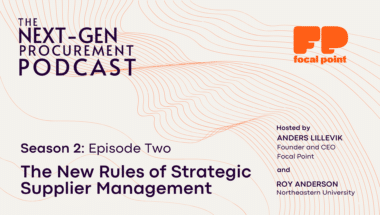What is a Procurement Scorecard?
Updated May 2024
Over the past few years, procurement has faced many unique challenges. Some have stemmed from outdated processes that solely focused on cost savings, others from increased product complexity relating to new ESG standards, supply shortages, and geopolitical events.
Historically, procurement performance management has been unidimensional, limiting reporting to singular factors, like cost savings. While an important KPI for procurement and strategic sourcing, cost savings is just one of the many things procurement manages. Cost savings alone does not reflect the whole and true value that procurement brings to the table. To portray the full picture of the benefits procurement creates (including strategic benefits) a scorecard that encompasses all of procurement’s efforts is critical.
Procurement needs a scorecard to measure optimal performance, that can combat the factors procurement is up against on the day-to-day. Organizations must assign weight to factors based on strategic priority. To remain competitive and bring true strategic value, procurement must stop making decisions on the fly related to cost savings.
The Complete Procurement Scorecard
As mentioned above, the game has changed, and procurement needs a scorecard that reflects that. According to a Spend Matters article, one different and effective approach to measuring and managing procurement performance now is to use “the Balanced Scorecard approach”—a framework of performance measurement that “adds strategic non-financial performance measures to traditional financial metrics and provides a more ‘balanced’ view of organizational performance.”
There are many factors that should be included on a procurement performance scorecard. All of the responsibilities that rest on procurement outside of cost savings should be included to ensure the entirety of procurement’s efforts are recognized within the organization. Things like operational statistics (PO coverage, % contract spend, payment stats, cycle times), client satisfaction, supplier diversity, and ESG metrics. We will go into further detail on each below.
Operational Statistics
When working to prove value, keeping track of operational statistics is an important piece of the procurement puzzle. These should include things like internal cycle times, percentage of purchase orders and releases received on time, percentage of requests met within a certain amount of business days, etc.
Did your order come on time? Did it come in full? Factors such as these must be considered. Each of these categories will have different levels of importance placed upon them based on your organization’s goals. But overall, your team’s efficiency and stakeholder satisfaction can be reported upon more accurately by keeping track of operational statistics.
Client Satisfaction
Just as the name suggests, client satisfaction refers to how well you are meeting the needs and expectations of your customers. This encompasses any interactions (before, during, and after the sale). This could be measured in polls, customer reviews, whatever is most helpful to help you keep on the pulse of what is working—or not working—so you can do what it takes to keep your customers happy.
In addition, it is crucial to maintain a good working relationship with clients throughout the procurement process so that you are able to maintain an ongoing, accurate measure of stakeholder satisfaction. This way, your team will be able to report on what is working well, and make adjustments as needed.
Non-Financial Benefits
Procurement must start showing how it is contributing directly towards the achievement of key business goals related to factors other than cost. Some of these non-financial benefits could include measures taken by procurement that relate to improving customer relationships, operations, quality, supplier relationships, and cycle-time.
As procurement’s responsibilities continue to expand beyond simply reducing costs, these non-financial KPIs will continue to increase in importance as they relate to communicating the strategic value created by the function.
Supplier Diversity
Supplier diversity has emerged as one of procurement’s most pressing concerns. There is pressure, particularly in North America, to include certified diverse suppliers in the supply chain. Furthermore, organizations are starting to require diversity among sub-tier suppliers as well. In order to build a more resilient supply chain, supplier diversity is critical.
The benefits have been proven time and again – diverse suppliers bring greater agility, cost savings, and increased flexibility to the sourcing process. As a result, many companies are beginning to require certified diverse suppliers and prioritizing SD&I.
ESG Metrics
In today’s climate, procurement teams cannot neglect to consider how they contribute to their organization’s sustainability efforts. For this reason, ESG has won its place on procurement’s scorecard. Some important ESG metrics that make a difference include: carbon footprint reduction, energy efficiency improvements, established business ethics, diversity and Inclusion, and product safety, just to name a few.
How Do We Get a Complete Procurement Scorecard?
To gain visibility on these many parameters, procurement needs to have integrated solutions that help automate and track traditional processes. Each organization has its own priorities, and the days of cost savings being the only KPI of strategic importance are over. Procurement must:
- Clearly define objectives and measures to track metrics
- Decide which metrics matter most
- Define each metric and establish benchmarks
- Access data that helps track KPIs and gives procurement visibility
Are you wondering how to create your scorecard? Get a demo from Focal Point. We’ll show you how to utilize the data you already have, optimize your processes, and measure results more accurately.
Written by Derek Walker



